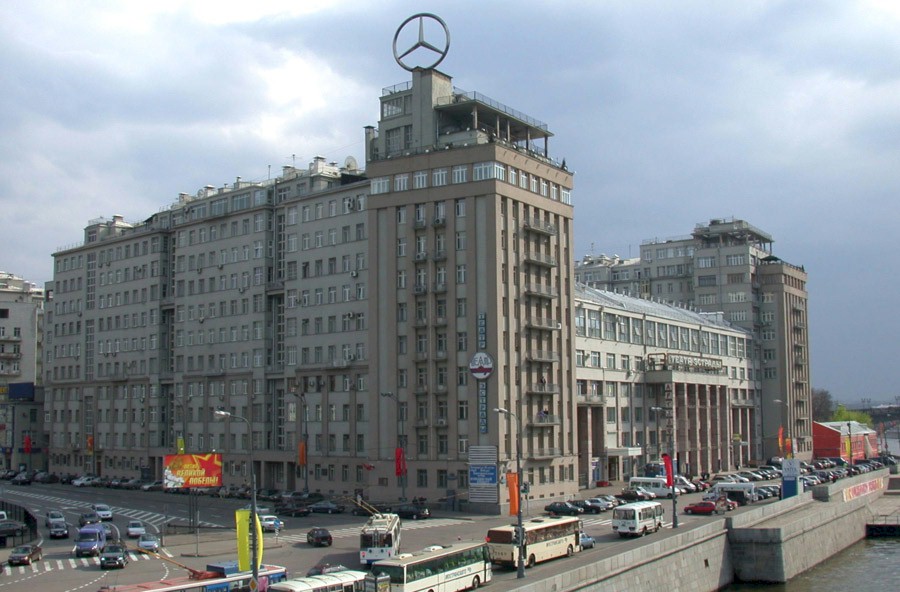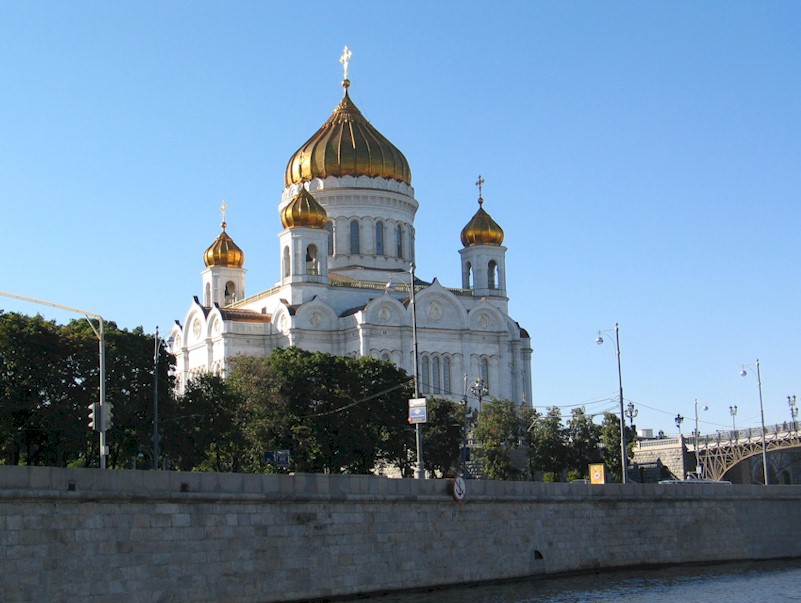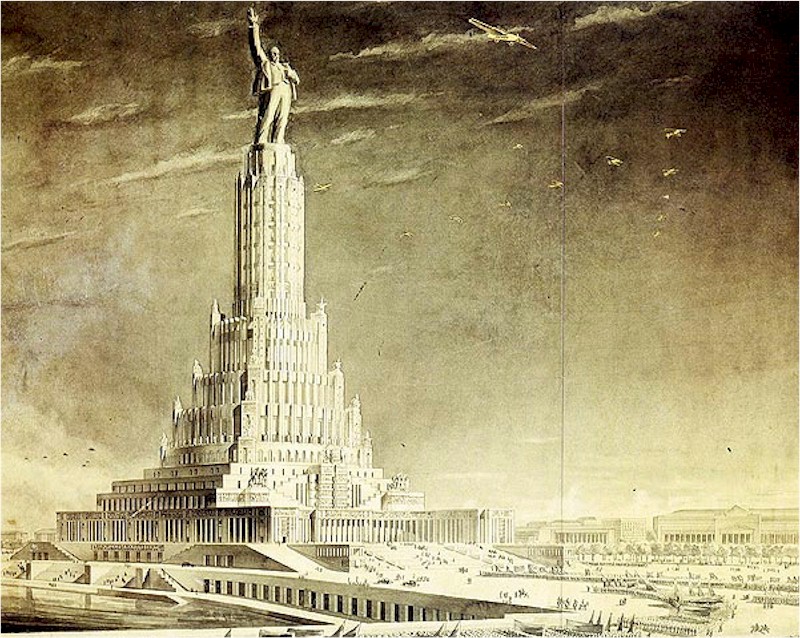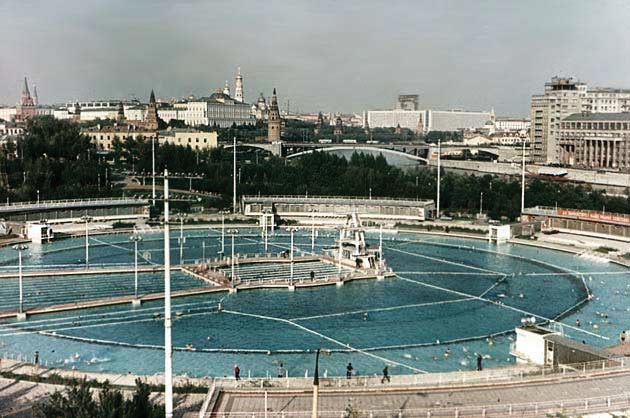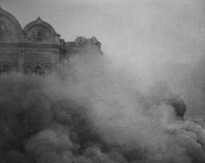The House on the Embankment
English > Locations > Locations from the novel > The House on the Embankment
The House on the Embankment
Arkadi Sempleyarov, described by Bulgakov as «the vain, conceited and especially unfaithful chairman of the Acoustics Commission of the Moscow theatres», lives close to the Каменный мост [Kamenni Most] or Stone Bridge in the Дом на набережной [Dom na Naberezjnoj] or the House on the Embankment.
This complex was constructed on the embankment of the Moscow river in 1928-1931 by architect Boris Mikhailovich Iofan (1891-1976). It was intended as a luxury and comfortable dwelling for the elite: highly ranked party leaders, people’s commissars, high army officers, actors, writers, artists and other heroes of the Soviet regime. That’s why it was not just an ordinary apartment building. It was almost a city on its own, with its own postal and telegramme office, a beauty salon, a laundry and much more. So the elite didn’t have to mingle with the ordinary people for practical day-to-day worries. Today the house has got a theatre, a movie theatre, two big stores and a museum.
The building is situated at the Serafimovikha ulitsa, on the bank of the river, and was called successively the Second Soviet People's Commissariat, the House of the USSR, the Government House and the House on the Embankment.
This last English name became quite famous by the book written by Yuri Valentinovich Trifonov (1925-1981) about the people living there. Trifonov has been living there himself, but after the fall into disfavour of his father Valentin Andreevich Trifonov (1888-1938), who once was a notorious Cossack leader, the family had to move out and go to a rather shabby коммуналка [kommunalka] oe communal apartment, a small flat where two or more families had to share one kitchen and one bathroom.
The Cathedral of Christ the Saviour
The House of the Embankment is surrounded by some other well-known buildings. One of them is the chocolate factory Красный Октябрь [Krasniy Oktober] or Red October, which is very famous in Russia - although the chocolate is far less tasty than the Belgian truffles and chocotoffs. The second famous building in the neighbourhood is the rebuilt Храм Христа Спасителя [Khram Khrista Spacitelya] or Cathedral of Christ the Saviour.
None of those two buildings are specifically mentioned by their names in the novel, though the cathedral plays a role in it. First, in chapter 4, when Ivan Bezdomny is chasing Woland's gang, he dives in the river «on the granite steps of the Moscow River amphitheatre». Later, in chapter 29, the cathedral is described as «a little hovel destined to be pulled down», when Woland looks over Moscow before leaving the city. The story of the Cathedral of Christ the Saviour is worth to tell, if only it was to show the megalomania and the absurd ideas of Stalin.
The current cathedral is of a fairly recent date, but it is an exact copy of the original cathedral, the construction of which began in 1839 under tsar Nicholas I, and which was inaugurated only 44 years later on May 26, 1883, the coronation day of tsar Alexander III. Actually, the cathedral should have been built on the Sparrow Hills. After all, Tsar Alexander I (1777-1825) had promised to build it oon the spot where the wooden Vorobyoy palace was destroyed in 1812 after the great fire that forced Napoleon Bonaparte (1769-1821) to withdraw from Moscow. Further on, you can read why the cathedral is not on Sparrow Hills.
After the Russian revolution, religion was officially abolished in the Soviet Union. The prominent position of the cathedral at the Moscow river embankment was a thorn in the flesh of Stalin, who had preferred to see a communist monument on that spot. He organised a competition, to which participated, among others, famous architects like Charles-Édouard Jeanneret-Gris (1887-1965), who was better known as Le Corbusier and Walter Gropius (1883-1969). The first prize was for an American project resembling to the White House. But Stalin did not like this neither.
So things went «back to normal» when, by the means of a «Special Prize of the Jury», Soviet citizen Boris Mikhailovich Iofan (1891-1976), who also had designed the House on the Embankment, was presented as the winner. His Palace of the Soviets was a skyscraper with a 100 meter high statue of Lenin on the top. The total height of the building should have been 415 meters, which would have made it the highest building in the world, even bigger than the Empire State Building. The arm that Lenin would stretch over Moscow would have been thirty meter.
In July, 1931 the demolition of the Cathedral started. The last pieces were blown up in December 1931. Some priests refusing to leave the Cathedral were killed for it. The writer Ilya Arnoldovich Faynzilberg (1897-1937), who formed the famous satirical writing partnership Ilf & Petrov together with Eugene Petrovich Kataev (1903-1942) - and who was highly appreciated by Bulgakov - was also an avid photographer. He witnessed the detonation of the cathedral and made photos of it.
Another witness of the destruction of the cathedral was the cameraman Vladislav Vladislavovich Mikosha (1909-2004), who just started his career in 1931 and who made a film about it.
Click here to watch Mikosha's film and an interview with him
When the construction of the Palace of the Soviets started, it appeared that no one had thought of the proximity of the river. Too much water from the Moscow river seeped into the soil, which made it impossible to erect such building on that particular spot. Eventually the project was cancelled by Party Secretary Nikita Sergeevich Khrushchev (1894-1971) in 1953, and the excavation was transformed in 1958 into the huge Москва бассейн [Moskva basseyn] or Moscow pool, which became the world's largest open air swimming pool.
The debacle of the Palace of the Soviets is reminiscent of something which had happened some hundred years before with the cathedral itself. In 1817, the then tsar Alexander I (1777-1825) wanted to build this cathedral on Sparrow Hills, where in Chapter 31 Woland and his retinue came together to say goodbye to Moscow. Bulgakov describes how «a huge slab of the bank sagged into the river». That refers to the construction of the cathedral that had to be stopped in 1827 because the mountain began to crumble and slide down. You can read more about this by clicking this link.
After the fall of communism, religion reinstated rapidly in Russia. In 1990, president Boris Nikolaevich Yeltsin (1931-2007) gave the permission to build a new cathedral following the original concept at the same location. In 1992, a fund was established for the reconstruction and the foundations were laid in 1994.
The new cathedral consists of two churches: the lower church, consecrated to the Saviour's Transfiguration, and the upper church. The lower church was inaugurated in 1996. The complete cathedral was inaugurated on August 19, 2000. In the basement, next to the lower church, there's a museum telling the story of the cathedral and the church's history in general.
Metro: Кропоткинская (Kropotkinsskaya)
Share this page |
